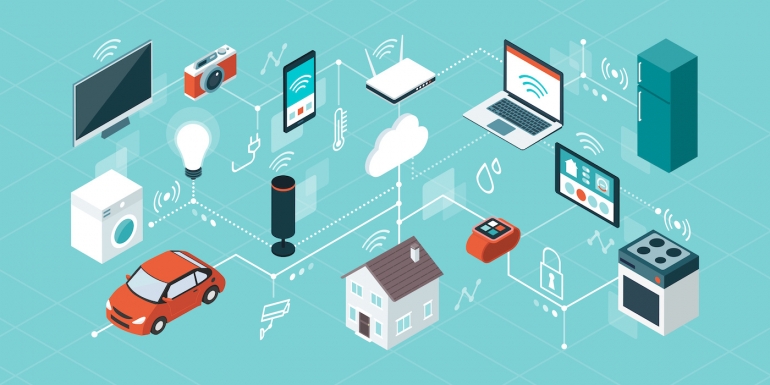The Internet of Things (IoT) refers to the interconnectivity of physical devices, vehicles, buildings, and other items that are embedded with sensors, software, and network connectivity. These devices are designed to collect and exchange data over the internet without the need for human intervention. With the IoT, we can monitor and control various systems remotely, from home appliances to complex industrial systems. The IoT is transforming the way we live and work, and it is rapidly growing in popularity. There are four main types of IoT, and in this article, we will explore each type in detail.
Consumer IoT
Consumer IoT is the most well-known type of IoT. This type of IoT involves smart devices that are designed for use by individuals in their homes or personal lives. These devices include smartphones, smartwatches, smart thermostats, smart home security systems, and smart appliances. Consumer IoT devices are typically designed to make life easier and more convenient for the user. They can be controlled remotely through a smartphone app, and they often use voice commands to operate.
The primary benefit of consumer IoT devices is that they offer a high degree of customization and control to the user. They can be programmed to suit individual preferences, and they can be integrated with other devices in the home to create a seamless and automated living experience. For example, a smart thermostat can be programmed to adjust the temperature based on the user’s schedule, while a smart home security system can be set to alert the user if there is a security breach.
Commercial IoT
Commercial IoT refers to the use of IoT devices in the workplace. This type of IoT includes a wide range of devices that are designed for use in industries such as manufacturing, logistics, and healthcare. Commercial IoT devices are used to improve efficiency, reduce costs, and increase productivity. They are often designed to monitor and optimize systems and processes, such as equipment maintenance and supply chain management.
One of the primary benefits of commercial IoT devices is that they can help businesses gain a competitive advantage. By collecting and analyzing data from a variety of sources, businesses can identify inefficiencies in their operations and make data-driven decisions to improve their bottom line. For example, a manufacturer might use IoT sensors to monitor the performance of its equipment, enabling it to identify potential issues before they become serious problems. This can reduce downtime and maintenance costs, resulting in significant savings for the business.
Industrial IoT
Industrial IoT is a subset of commercial IoT that is specifically designed for use in heavy industries such as oil and gas, mining, and manufacturing. Industrial IoT devices are typically used to monitor and control large-scale systems and processes. They often use sensors and other advanced technologies to collect data and provide insights into how these systems are performing. Industrial IoT devices are designed to improve safety, increase efficiency, and reduce costs.
One of the primary benefits of industrial IoT devices is that they enable businesses to gather data on their operations in real-time. This data can be used to optimize processes and reduce waste, resulting in significant cost savings. For example, an oil and gas company might use IoT sensors to monitor the flow rate of oil and gas through a pipeline. By analyzing this data, the company can identify potential leaks or other issues that could result in costly downtime or environmental damage.
Infrastructure IoT
Infrastructure IoT refers to the use of IoT devices in public infrastructure such as transportation systems, utilities, and city services. These devices are designed to monitor and optimize the performance of these systems, making them more efficient and cost-effective. Infrastructure IoT devices can be used to track traffic patterns, monitor energy consumption, and manage waste disposal systems.
One of the primary benefits of infrastructure IoT devices is that they can help governments and municipalities to provide better services to their citizens. By monitoring and optimizing infrastructure systems, governments can reduce costs and improve efficiency. For example, a city might use IoT sensors to monitor traffic patterns and adjust traffic lights accordingly. This can help to reduce traffic congestion, improve air quality, and reduce fuel consumption. Similarly, a utility company might use IoT sensors to monitor energy consumption in homes and businesses, enabling it to better manage the supply and demand of energy and reduce costs for both the company and its customers.
Infrastructure IoT devices can also be used to improve public safety. For example, cities might use IoT sensors to monitor air quality and detect potential environmental hazards, such as pollution or natural disasters. This information can be used to alert citizens and emergency services and to take preventive measures to minimize the impact of these events.
Overall, the IoT is transforming the way we live and work, and the four types of IoT discussed in this article are at the forefront of this transformation. From consumer IoT devices that make our lives more convenient to industrial IoT devices that optimize complex manufacturing processes, the IoT is driving innovation and improving efficiency in every sector. And as governments and municipalities increasingly turn to infrastructure IoT devices to improve public services and safety, we can expect to see even greater benefits in the years to come.







